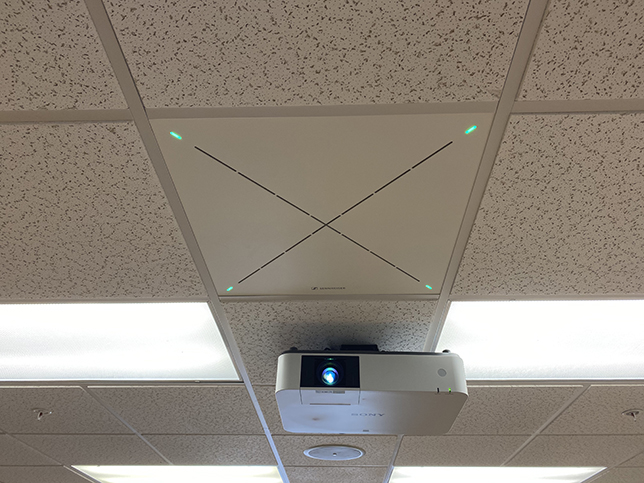USF Tackles Classroom HyFlex Learning Work
- By Dian Schaffhauser
- 03/10/21
An effort at the University of South Florida has resulted in nearly a hundred classrooms being readied for simultaneous remote and in-person learning. The updates included installation of touchless sound systems and dual cameras.
Pre-pandemic, the institution's information technology division had tested and subsequently purchased a Sennheiser TeamConnect Ceiling 2 (TCC2) system in a main conference room. As Noah Kessler, technology & systems manager for the university, noted, "We always wanted to be able to mic an entire classroom, but until then didn't see a solid cost-effective solution."

Each of the 96 classrooms in the University of South Florida's recent HyFlex project was outfitted with a Sennheiser TeamConnect Ceiling 2, audience cam and professor cam.
Photo courtesy of the University of South Florida
When the university closed in-person operations in March 2020, IT ran an inventory of classrooms on campus. As Michael Kraus, Audio Vision Engineering & Systems, explained in a case study on the project, the team wanted details: "Did a particular room have a PC and an instructor source, or just a wall plate? Did it have HDMI? Was it analog?"
By April, the assessment was done, and IT had put together a design for what a HyFlex set-up would look like in some 700 classrooms—as well as what it would cost.
The university's team of IT and audio-visual experts engaged systems integration firm AVI-SPL to assist with the installation. The physical deployment began with 96 classrooms in 17 buildings and took three weeks, with the goal of being ready for the start of class in fall 2020.
In addition to the TCC2 microphone system, which handled all the audio signals, each room was outfitted with two cameras, one facing the students and the other facing the lecturer.
"For the most part, most of the signal routing was pretty straightforward," said Kessler. "Typically, we would take the analog out, connect this to our Crestron processor and then back out of it. If it came to needing more mics, we could integrate other Crestron USB mixers, or alternatively send signals straight into the computer using a Dante USB adapter. That's the beauty of this system, because some competing units only offer Dante connectivity, or in some cases just an analog out. These limitations would have made the project a lot more difficult."
Kessler noted that what really impressed him was how well the microphone system worked out of the box. "Hang and bang, tweak a couple settings, and then you are off to the next room. As far as performance, the audio is very clear, and I really like the fact that you can create exclusion zones in two dimensions in case you have noise from an HVAC system or something — this is very exciting."
"The ability for a professor to walk into a room, not have to put a mic on and just focus on what they need communicate to the students is extremely valuable," Kraus added.
Now, the team meets regularly to discuss necessary tweaks and changes. "This is a living system, and we are feeling like we are taking all the right steps—particularly with TCC2," said Kraus.
The mic and camera setup will be used for all future standard classrooms, he said, "regardless of whether or not they have flexible hybrid requirements."
About the Author
Dian Schaffhauser is a former senior contributing editor for 1105 Media's education publications THE Journal, Campus Technology and Spaces4Learning.